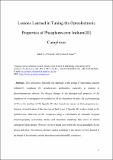Files in this item
Lessons learned in tuning the optoelectronic properties of phosphorescent iridium(III) complexes
Item metadata
| dc.contributor.author | Henwood, Adam F. | |
| dc.contributor.author | Zysman-Colman, Eli | |
| dc.date.accessioned | 2017-11-18T00:32:16Z | |
| dc.date.available | 2017-11-18T00:32:16Z | |
| dc.date.issued | 2017-01-16 | |
| dc.identifier | 247933689 | |
| dc.identifier | d38b6749-72e0-4bdc-ae42-48b04de3f09c | |
| dc.identifier | 85009197937 | |
| dc.identifier | 000393797900001 | |
| dc.identifier.citation | Henwood , A F & Zysman-Colman , E 2017 , ' Lessons learned in tuning the optoelectronic properties of phosphorescent iridium(III) complexes ' , Chemical Communications , vol. 53 , no. 5 , pp. 807-826 . https://doi.org/10.1039/C6CC06729H | en |
| dc.identifier.issn | 1359-7345 | |
| dc.identifier.other | ORCID: /0000-0001-7183-6022/work/56639122 | |
| dc.identifier.uri | https://hdl.handle.net/10023/12135 | |
| dc.description | EZ-C acknowledges past and present group members for their tireless efforts and enthusiasm and the University of St Andrews for financial support. The authors would like to thank the Engineering and Physical Sciences Research Council for financial support for Adam Henwood (EPSRC DTG Grants: EP/J500549/1; EP/K503162/1; EP/L505097/1) | en |
| dc.description.abstract | This perspective illustrates our approach in the design of heteroleptic cationic iridium(III) complexes for optoelectronic applications, especially as emitters in electroluminescent devices. We discuss changes in the photophysical properties of the complexes as a consequence of modification of the electronics of either the cyclometalating (C^N) or the ancillary (N^N) ligands. We then broach the impact on these properties as a function of modification of the structure of both types of ligands. We explain trends in the optoelectronic behaviour of the complexes using a combination of rationally designed structure-property relationship studies and theoretical modelling that serves to inform subsequent ligand design. However, we have found cases where the design paradigms do not always hold true. Nevertheless, all these studies contribute to the lessons we have learned in the design of heteroleptic cationic phosphorescent iridium(III) complexes. | |
| dc.format.extent | 20 | |
| dc.format.extent | 3923285 | |
| dc.language.iso | eng | |
| dc.relation.ispartof | Chemical Communications | en |
| dc.subject | QD Chemistry | en |
| dc.subject | T-NDAS | en |
| dc.subject.lcc | QD | en |
| dc.title | Lessons learned in tuning the optoelectronic properties of phosphorescent iridium(III) complexes | en |
| dc.type | Journal article | en |
| dc.contributor.institution | University of St Andrews. School of Chemistry | en |
| dc.contributor.institution | University of St Andrews. Organic Semiconductor Centre | en |
| dc.contributor.institution | University of St Andrews. EaSTCHEM | en |
| dc.identifier.doi | https://doi.org/10.1039/C6CC06729H | |
| dc.description.status | Peer reviewed | en |
| dc.date.embargoedUntil | 2017-11-17 |
This item appears in the following Collection(s)
Items in the St Andrews Research Repository are protected by copyright, with all rights reserved, unless otherwise indicated.

